

Reclaimed Wastewater for Drinking: Safe but Still a Tough Sell. Water and Wastewater.Com, Water Treatment Equipment Homepage. Failure to Act. ASCE’s Failure to Act economic report series shows the economic consequences of continued underinvestment in our nation’s infrastructure, and the economic gains that could be made by 2020 in terms of GDP, personal disposable income, exports, and jobs if we choose as a country to invest in our communities.
The culminating report was released on January 15, 2013 and presents an overall picture of the economic opportunity associated with infrastructure investment and the cost of failing to fill the investment gap. ASCE finds that with an additional investment of $157 billion a year between now and 2020, the U.S. can eliminate this drag on economic growth and protect: $3.1 trillion in GDP, almost the equivalent of Germany’s entire GDP$1.1 trillion in U.S. trade value, equivalent to Mexico’s GDP 3.5 million jobs, more than the jobs created in the U.S. over the previous 22 months$2.4 trillion in consumer spending, comparable to Brazil’s GDP$3,100 in annual personal disposable income. Www.wefnet.org/ewef/images/MOP11/Frontmatter.pdf. Renewable Energy & Water - Waste Treatment.
Methods of Liquid Waste Treatment. A high BOD indicates the prescence of excess amounts of organic carbon.
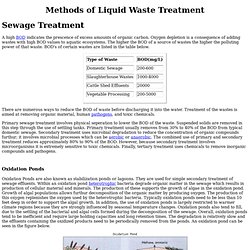
Oxygen depletion is a consequence of adding wastes with high BOD values to aquatic ecosystems. Centralized Waste Treatment. Why Cleaned Wastewater Stays Dirty In Our Minds. Hide captionA boom sweeps around a tank at a sewage treatment plant in Coos Bay, Ore.
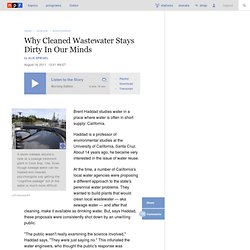
Even though sewage water can be treated and cleaned, psychologists say getting the "cognitive sewage" out of the water is much more difficult. Jeff Barnard/AP A boom sweeps around a tank at a sewage treatment plant in Coos Bay, Ore. Even though sewage water can be treated and cleaned, psychologists say getting the "cognitive sewage" out of the water is much more difficult.
Brent Haddad studies water in a place where water is often in short supply: California. Haddad is a professor of environmental studies at the University of California, Santa Cruz. At the time, a number of California's local water agencies were proposing a different approach to the state's perennial water problems. "The public wasn't really examining the science involved," Haddad says.
"That's what I would hear at these water agency meetings," Haddad says, "these very frustrated water engineers saying, 'My public is irrational! Reclaimed water. Reclaimed water or recycled water, is former wastewater (sewage) that is treated to remove solids and certain impurities, and used in sustainable landscaping irrigation or to recharge groundwater aquifers.
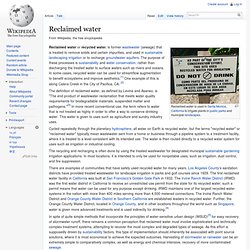
The purpose of these processes is sustainability and water conservation, rather than discharging the treated water to surface waters such as rivers and oceans. In some cases, recycled water can be used for streamflow augmentation to benefit ecosystems and improve aesthetics.[1] One example of this is along Calera Creek in the City of Pacifica, CA. [2] The definition of reclaimed water, as defined by Levine and Asaneo, is "The end product of wastewater reclamation that meets water quality requirements for biodegradable materials, suspended matter and pathogens.
"[3] In more recent conventional use, the term refers to water that is not treated as highly in order to offer a way to conserve drinking water. History[edit] Maximum water recovery[edit] Benefits[edit] Concerns[edit] How Wastewater Treatment Works. The Seaterra Program provides the foundation for wastewater treatment in the core area and Greater Victoria for the next century.
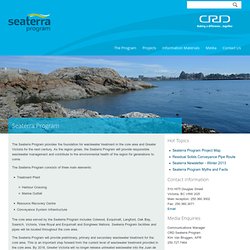
As the region grows, the Seaterra Program will provide responsible wastewater management and contribute to the environmental health of the region for generations to come. The Seaterra Program consists of three main elements: Treatment Plant Harbour Crossing Marine Outfall Resource Recovery Centre Conveyance System Infrastructure The core area served by the Seaterra Program includes Colwood, Esquimalt, Langford, Oak Bay, Saanich, Victoria, View Royal and Esquimalt and Songhees Nations.
Seaterra Program facilities and pipes will be located throughout the core area. The Seaterra Program will provide preliminary, primary and secondary wastewater treatment for the core area. Recent News. Primary Wastewater Treatment. Sewage treatment. The objective of sewage treatment is to produce a disposable effluent without causing harm to the surrounding environment, and prevent pollution.[1] Sewage treatment is the process of removing contaminants from wastewater and household sewage, both runoff (effluents), domestic, commercial and institutional.
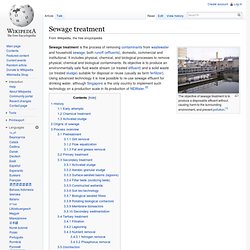
It includes physical, chemical, and biological processes to remove physical, chemical and biological contaminants. Its objective is to produce an environmentally safe fluid waste stream (or treated effluent) and a solid waste (or treated sludge) suitable for disposal or reuse (usually as farm fertilizer). Using advanced technology it is now possible to re-use sewage effluent for drinking water, although Singapore is the only country to implement such technology on a production scale in its production of NEWater.[2] History[edit] Basic sewer systems were used for waste removal in ancient Mesopotamia, where vertical shafts carried the waste away into cesspools. Early attempts[edit]